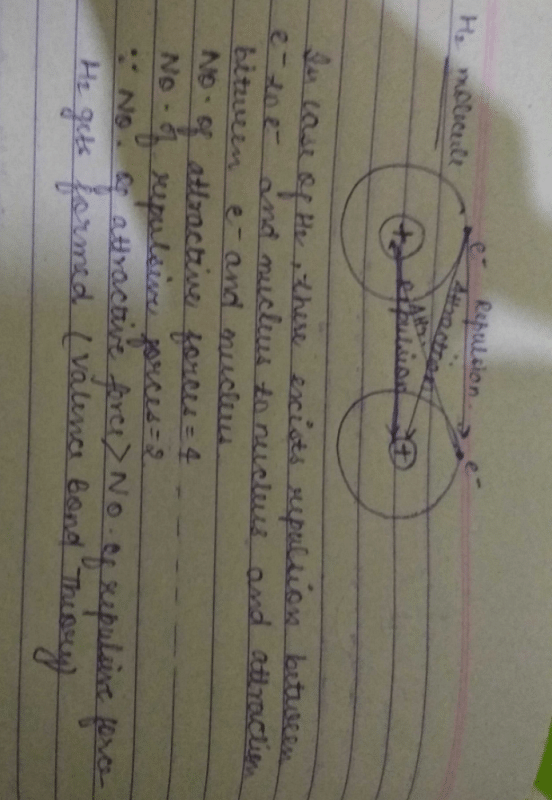Class 11 Exam > Class 11 Questions > Formation of H2 molecule on basis of Valence ...
Start Learning for Free
Formation of H2 molecule on basis of Valence bond theory ?
Most Upvoted Answer
Formation of H2 molecule on basis of Valence bond theory ?
Formation of H2 Molecule on Basis of Valence Bond Theory
Introduction
Valence Bond Theory (VBT) is a chemical bonding theory that explains the formation of chemical bonds between atoms due to the overlapping of their valence orbitals. In this theory, the bond formation occurs due to the sharing of electrons between atoms, leading to the formation of covalent bonds. In this article, we will discuss the formation of H2 molecule on the basis of Valence Bond Theory.
Formation of H2 Molecule
The H2 molecule is formed by the combination of two hydrogen atoms. Each hydrogen atom has one electron in its 1s orbital. During the formation of H2 molecule, these two hydrogen atoms share their electrons to form a covalent bond.
Valence Electrons in H2 Molecule
In the H2 molecule, each hydrogen atom contributes one electron to form a covalent bond. Therefore, the H2 molecule has a total of two valence electrons.
Overlapping of Orbitals
The formation of a covalent bond between two hydrogen atoms involves the overlapping of their 1s orbitals. The two hydrogen atoms approach each other and their 1s orbitals overlap to form a molecular orbital. The molecular orbital is a combination of the two atomic orbitals.
Bond Formation
The overlapping of the 1s orbitals of the two hydrogen atoms leads to the formation of a sigma (σ) bond. The sigma bond is formed due to the head-on overlap of the atomic orbitals. The electrons in the sigma bond are shared equally between the two hydrogen atoms.
Conclusion
On the basis of Valence Bond Theory, we can conclude that the H2 molecule is formed due to the sharing of valence electrons between two hydrogen atoms. The covalent bond is formed due to the overlapping of 1s orbitals of the hydrogen atoms, leading to the formation of a sigma bond.
Community Answer
Formation of H2 molecule on basis of Valence bond theory ?

Attention Class 11 Students!
To make sure you are not studying endlessly, EduRev has designed Class 11 study material, with Structured Courses, Videos, & Test Series. Plus get personalized analysis, doubt solving and improvement plans to achieve a great score in Class 11.

|
Explore Courses for Class 11 exam
|

|
Similar Class 11 Doubts
Formation of H2 molecule on basis of Valence bond theory ?
Question Description
Formation of H2 molecule on basis of Valence bond theory ? for Class 11 2024 is part of Class 11 preparation. The Question and answers have been prepared according to the Class 11 exam syllabus. Information about Formation of H2 molecule on basis of Valence bond theory ? covers all topics & solutions for Class 11 2024 Exam. Find important definitions, questions, meanings, examples, exercises and tests below for Formation of H2 molecule on basis of Valence bond theory ?.
Formation of H2 molecule on basis of Valence bond theory ? for Class 11 2024 is part of Class 11 preparation. The Question and answers have been prepared according to the Class 11 exam syllabus. Information about Formation of H2 molecule on basis of Valence bond theory ? covers all topics & solutions for Class 11 2024 Exam. Find important definitions, questions, meanings, examples, exercises and tests below for Formation of H2 molecule on basis of Valence bond theory ?.
Solutions for Formation of H2 molecule on basis of Valence bond theory ? in English & in Hindi are available as part of our courses for Class 11.
Download more important topics, notes, lectures and mock test series for Class 11 Exam by signing up for free.
Here you can find the meaning of Formation of H2 molecule on basis of Valence bond theory ? defined & explained in the simplest way possible. Besides giving the explanation of
Formation of H2 molecule on basis of Valence bond theory ?, a detailed solution for Formation of H2 molecule on basis of Valence bond theory ? has been provided alongside types of Formation of H2 molecule on basis of Valence bond theory ? theory, EduRev gives you an
ample number of questions to practice Formation of H2 molecule on basis of Valence bond theory ? tests, examples and also practice Class 11 tests.

|
Explore Courses for Class 11 exam
|

|
Signup for Free!
Signup to see your scores go up within 7 days! Learn & Practice with 1000+ FREE Notes, Videos & Tests.

























